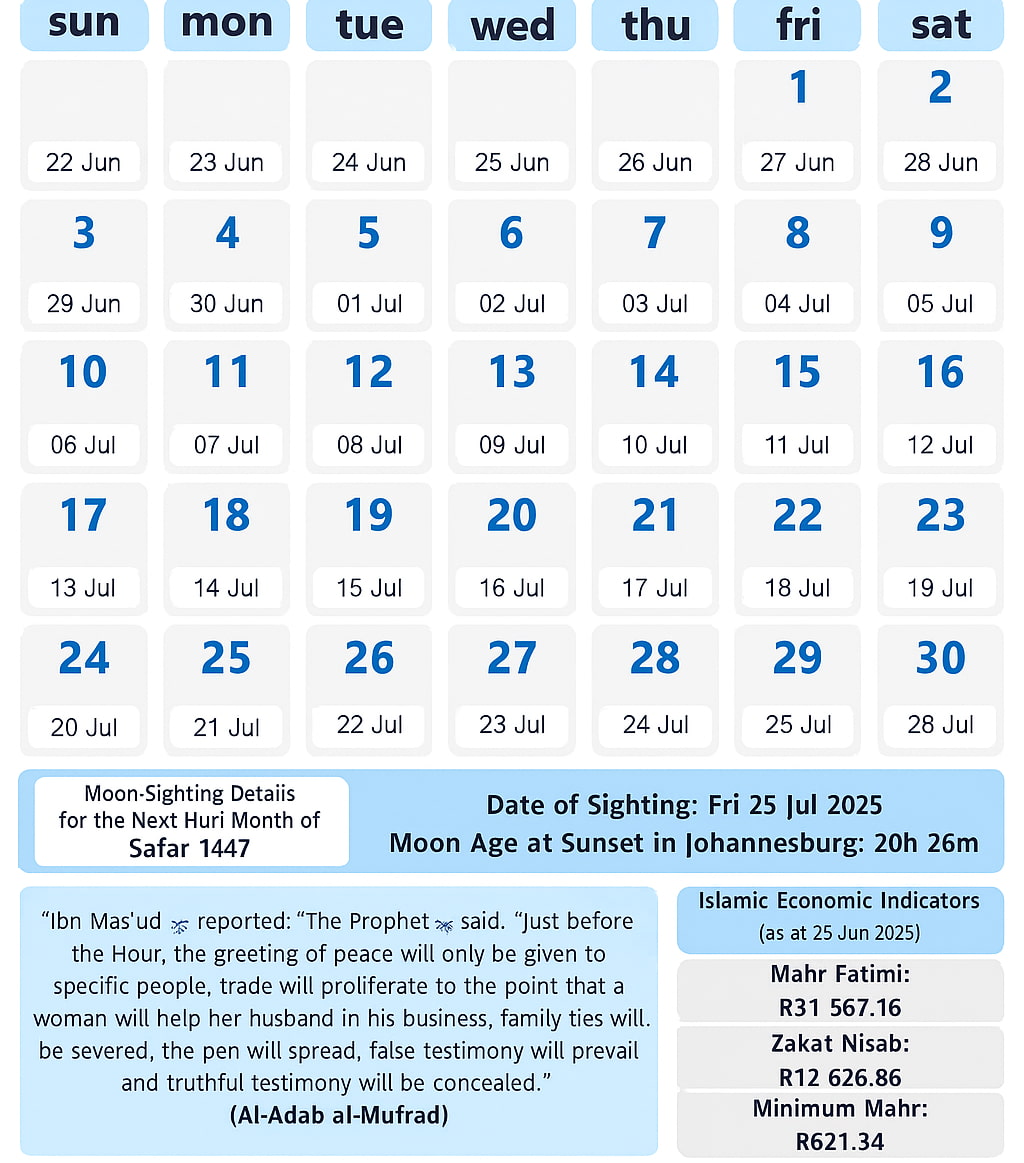The Islamic calendar of 2025 starts with the month of Rajab. The Islamic year 1446 will end in June. The year 2025 will end on the Islamic month of Rajab.
For more like this, click here.

What Is the Islamic Calendar?
The Islamic calendar is based on the moon’s cycles, unlike the Gregorian calendar which follows the solar year. The first year of the Islamic calendar corresponds to 622 CE, the year when the Prophet Muhammad (peace be upon him) migrated from Makkah to Madinah — an event known as the Hijrah. This marks the beginning of the Hijri Era.
Each Islamic month starts with the sighting of the new moon, and because of this, Islamic dates can vary slightly based on geographical location and moon visibility.
List of Islamic Months
The 12 months of the Islamic calendar are:
- Muharram
- Safar
- Rabi al-Awwal
- Rabi al-Thani
- Jumada al-Awwal
- Jumada al-Thani
- Rajab
- Sha’ban
- Ramadan
- Shawwal
- Dhul-Qi’dah
- Dhul-Hijjah
Each of these months has spiritual or historical importance in Islam, but four months—Muharram, Rajab, Dhul-Qi’dah, and Dhul-Hijjah—are regarded as sacred months in which warfare is traditionally forbidden.
Key Islamic Dates in Gregorian Year 2025
Here are the major Islamic events expected in 2025. Note that dates may differ by a day depending on moon sighting.
| Event | Hijri Date | Estimated Gregorian Date (2025) |
|---|---|---|
| Islamic New Year (1447 AH) | 1 Muharram 1447 | ~June 29, 2025 |
| Day of Ashura | 10 Muharram 1447 | ~July 8, 2025 |
| Mawlid al-Nabi (Prophet’s Birthday) | 12 Rabi al-Awwal 1447 | ~September 14, 2025 |
| Start of Ramadan | 1 Ramadan 1446 | ~February 28, 2025 |
| Laylat al-Qadr (Night of Decree) | 27 Ramadan 1446 | ~March 26, 2025 |
| Eid al-Fitr | 1 Shawwal 1446 | ~March 30, 2025 |
| Hajj Days | 8–13 Dhul-Hijjah 1446 | ~June 4–9, 2025 |
| Day of Arafah | 9 Dhul-Hijjah 1446 | ~June 7, 2025 |
| Eid al-Adha | 10 Dhul-Hijjah 1446 | ~June 8, 2025 |
All dates are approximate and depend on local moon sightings.
Significance of Key Months in 2025
Ramadan (1–29/30 Ramadan 1446)
Ramadan is the ninth month and the most spiritually significant period of the Islamic year. It is a time of fasting, prayer, and reflection. Muslims fast from dawn to sunset, abstaining from food, drink, and other physical needs. The month is believed to be when the Qur’an was first revealed.
In 2025, Ramadan is expected to begin around February 28 and end on March 30, depending on moon sighting. Laylat al-Qadr, considered the Night of Power, falls in the last 10 nights—most commonly observed on the 27th night (March 26, 2025).
Eid al-Fitr (1 Shawwal 1446)
Eid al-Fitr is the festival of breaking the fast, celebrated the day after Ramadan ends. It is a joyous occasion where Muslims gather for communal prayers, give Zakat al-Fitr (charity), and celebrate with feasts and gifts. In 2025, Eid al-Fitr is expected to fall on March 30.
Dhul-Hijjah and Hajj (8–13 Dhul-Hijjah 1446)
Dhul-Hijjah, the 12th and final month, is known for the Hajj pilgrimage—one of the five pillars of Islam. It is obligatory once in a lifetime for Muslims who are physically and financially able.
Key days include:
- 8th Dhul-Hijjah (Yawm al-Tarwiyah): Pilgrims enter the state of Ihram.
- 9th Dhul-Hijjah (Day of Arafah): Pilgrims gather on the plain of Arafah; this is the most crucial day of Hajj.
- 10th Dhul-Hijjah (Eid al-Adha): The Feast of Sacrifice, marking Prophet Ibrahim’s (AS) willingness to sacrifice his son.
In 2025, Hajj is expected to begin around June 4, with Eid al-Adha on June 8.
Islamic New Year (1 Muharram 1447)
The Islamic New Year begins with Muharram, a sacred month. In 2025, 1 Muharram 1447 will fall around June 29. While it’s not celebrated in the festive way of Gregorian New Year, it is a time for reflection and renewal of faith.
The 10th of Muharram, known as Ashura, is especially significant. For Sunni Muslims, it marks the day Allah saved Prophet Musa (Moses) and the Israelites. For Shi’a Muslims, it is a day of mourning the martyrdom of Imam Hussain (RA) at Karbala.
How the Hijri Calendar Affects Islamic Practice
Because Islamic rituals—like fasting, Hajj, and Eid—are based on the lunar calendar, they shift every year by approximately 10–11 days earlier in the Gregorian calendar. This results in Muslim holidays falling in different seasons over time.
For example, in the past decade, Ramadan has moved from summer to spring and will continue shifting into winter over the next few years. This affects fasting hours, climate, and daily routines.
Importance of Moon Sighting
The start of each Islamic month depends on the physical sighting of the crescent moon (Hilal), making observances variable between regions. Some communities follow local sightings, others rely on global reports or astronomical calculations.
This sometimes leads to differences in when Ramadan or Eid is observed, especially across countries or even cities. Despite these differences, the essence of Islamic worship remains unified.
Digital Tools and Islamic Calendars
In 2025, many Muslims will continue to rely on Islamic calendar apps, websites, and Masjid announcements for accurate Hijri dates. Institutions like the Islamic Society of North America (ISNA) or Majlis-e-Ulama in the UK and South Asia often release yearly calendars to help Muslims plan important dates.
Some popular Islamic calendar apps include:
- Muslim Pro
- IslamicFinder
- Hijri Calendar by Islamicity
The Islamic calendar is not just a way to mark time, it is a sacred structure that guides spiritual life, religious obligations, and historical remembrance..


